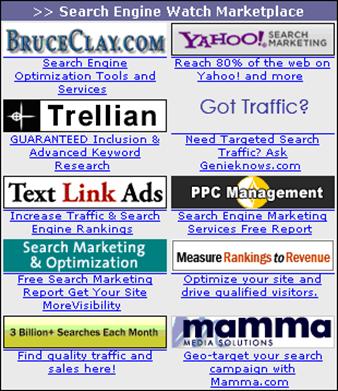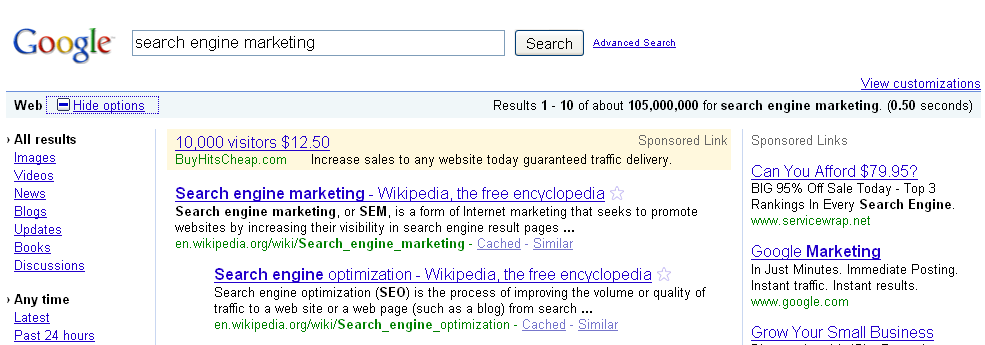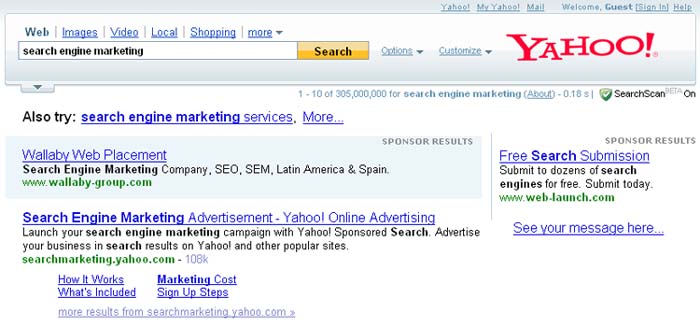As you know from the section of the course that discussed the history of search engines and optimization, there was a time when the optimization process was simple and involved little more that tweaking meta tags and repeating keywords within the content of a page. As such, there were a limited number of SEO companies.
Today the industry is highly competitive. Worldwide, there are now thousands of search engine optimization companies. There is also an ever increasing number of websites and many of them are already well optimized, making the competition much worse. In the past, when an SEO company optimized a client's site, most other sites in direct competition were poorly optimized or not optimized at all; the game was easier. But now, almost every competitor of yours is using the services of some SEO to optimize their site.
As you can guess, this makes the game really tough. Also, this leads up to half of the SEO / SEM companies into considering unethical and illegal strategies in order to get their customers to the top of search engine result pages.
Nevertheless, this rarely gives these companies any competitive advantage as most solid and respectable companies seeking SEO services now recognize that guarantees of top-10 rankings sound, at the very least, suspicious.
Let's imagine a company called FakeCompany LTD has a website that offers some products. Except product advertising, this site does not contain any valuable information for visitors so the search engines do not rank it high. So, FakeCompany hires SEO expert Mr. Doe to help them with rankings because Mr. Doe claims he can get any site into the Top-10.
What this SEO expert does is stuff the company pages with irrelevant keywords, creating a link system with thousands of hidden links and then implements some advanced spamming techniques like dynamic page generation and cloaking.
As a result, the rankings of the page are initially boosted. FakeCompany is happy and pays the fee to Mr. Doe.
Still, visitors coming to the site see even more of a mess than before the "optimization" and they are still unable to find any valuable content. Since they find the FakeCompany's site for the irrelevant keywords, that is, not for those they are primarily seeking, the conversion of visitors into customers is very low.
As a result, customers are unsatisfied and FakeCompany receives huge bills for traffic which hasn't been converted and hasn't brought any real profit.
The search engine which allowed for the spammer's site on top of its listings is also unsatisfied since it's losing its popularity among Web surfers because they are serving irrelevant pages. So it invests money into developing a more advanced spider that finally cracks Mr. Doe's tricks and the positions of FakeCompany fall down. Eventually, FakeCompany is excluded from the search engine index entirely because an unsatisfied visitor or a competitor reported to the search engine that FakeCompany is using spam methods.
Of course, FakeCompany is unsatisfied with this situation and sues Mr. Doe to get their money refunded. Mr. Doe is unwilling to cooperate or perhaps even managed to escape before all this mess started. The best case scenario is that FakeCompany gets its money back but is never able to restore its rankings and has to invest in a new website.
Nobody is satisfied in this story, however such things do happen now and again, even in today's more sophisticated SEO environment.
Unfortunately, there's no solution for such cases except abandoning spam techniques entirely and following a Code of Ethics for all Search Engine Optimizers which maintains their good reputation and withstand crowds of unethical SEO companies that wave the banner of illegal yet "effective" promotion strategies.
Adhering to a Code of Ethics (or Code of Conduct), if presented properly, may serve as an effective competitive advantage.
As we believe that such Codes should be unified across the Web, we will not invent our own. Instead, we support the one maintained by a well-known industry expert Bruce Clay and his company. This perfect collection of rules can be found at www.bruceclay.com and we provide a copy here for your reference.
No SEO practitioner will intentionally do harm to a client. This involves the continued use of any technology or procedure (without appropriate care) that is known to result in having the client site removed from search engine indexes or directories or rendered inoperative. Questionable adherence to standards must be addressed via the Robots Exclusion Standard.
No SEO practitioner will intentionally violate any specifically published and enforced rules of search engines or directories. Should rules and guidelines change (as they often do), the SEO practitioner will promptly take action to comply with the changes as they apply to all clients. Where rules and guidelines are unclear, the SEO practitioner will seek clarification and await approval from the appropriate search engine before continuing to utilize potentially harmful technology or procedures.
No SEO practitioner will intentionally mislead, harm or offend a consumer. All individuals utilizing a search engine to visit a site will not be misled by the information presented to or by the search engine or harmed or offended upon arrival at the client site. This includes techniques like "bait and switch" where the client page does not substantially contain and is not clearly associated with the optimized phrase or may be reasonably offensive to targeted visitors.
No SEO practitioner will intentionally violate any laws. This involves the deliberate and continued violation of copyright, trademark, servicemark or laws related to spamming as they may exist at the state, federal or international level.
No SEO practitioner will falsely represent the content of the client site. This includes the practice of presenting different versions of Web pages to different users except where that information is altered solely to meet browser specifications and needs, sensitivity to regional factors such as language or product specific needs. In general, ALL requests for a specific URL should be served identical HTML by the Web server.
No SEO practitioner will falsely represent others work as their own. This includes the taking of work from others in whole or in part and representing this work as their own. The SEO practitioner may not make verbatim copies of the work of others (instead of authoring original work) without the prior consent of the other party.
No SEO practitioner will misrepresent their own abilities, education, training, standards of performance, certifications, trade group affiliations, technical inventory or experiences to others. This includes quantifiable statements related to project timetables, performance history, company resources (staff, equipment and proprietary products) and client lists. Guarantees will be restricted to items over which the SEO practitioner has significant and reasonable control.
No SEO practitioner will participate in a conflict of interest without prior notice to all parties involved. This includes the practice of choosing to emphasize one client over another in competing keywords because there is more personal gain for the practitioner. All clients are treated equally and all will receive equal best effort in their Search Engine Optimization.
No SEO practitioner will set unreasonable client expectations. This includes the practice of accepting more than a reasonable number of clients competing for the same keywords and implying that all will be in the top positions in the search engines. This also includes the implication that results can be obtained in an unreasonable amount of time given the known condition of the search engines, client site and competition.
All SEO practitioners will offer their clients both internal and external dispute resolution procedures. This includes the publishing of address and phone numbers on primary Web pages, the inclusion of third-party dispute resolution links prominently placed within the practitioner’s website and contracts that include sections discussing dispute resolution.
All SEO practitioners will protect the confidentiality and anonymity of their clients with regards to privileged information and items implying testimonial support for the SEO practitioner. All staff of SEO practitioner shall be bound to protect information that is not generally known as it may harm the client. The SEO practitioner will not include the publishing of testimonials and proprietary logos of client lists, press releases and other collateral discussing the client without explicit approvals.”
We try to keep our sites and services compliant with this code and advise that you do the same; however, if you don't wish to use this code, you are welcome to make any custom modifications or invent your own Code, as long as it remains legal, transparent and ethical.
Today the industry is highly competitive. Worldwide, there are now thousands of search engine optimization companies. There is also an ever increasing number of websites and many of them are already well optimized, making the competition much worse. In the past, when an SEO company optimized a client's site, most other sites in direct competition were poorly optimized or not optimized at all; the game was easier. But now, almost every competitor of yours is using the services of some SEO to optimize their site.
As you can guess, this makes the game really tough. Also, this leads up to half of the SEO / SEM companies into considering unethical and illegal strategies in order to get their customers to the top of search engine result pages.
Nevertheless, this rarely gives these companies any competitive advantage as most solid and respectable companies seeking SEO services now recognize that guarantees of top-10 rankings sound, at the very least, suspicious.
Let's imagine a company called FakeCompany LTD has a website that offers some products. Except product advertising, this site does not contain any valuable information for visitors so the search engines do not rank it high. So, FakeCompany hires SEO expert Mr. Doe to help them with rankings because Mr. Doe claims he can get any site into the Top-10.
What this SEO expert does is stuff the company pages with irrelevant keywords, creating a link system with thousands of hidden links and then implements some advanced spamming techniques like dynamic page generation and cloaking.
As a result, the rankings of the page are initially boosted. FakeCompany is happy and pays the fee to Mr. Doe.
Still, visitors coming to the site see even more of a mess than before the "optimization" and they are still unable to find any valuable content. Since they find the FakeCompany's site for the irrelevant keywords, that is, not for those they are primarily seeking, the conversion of visitors into customers is very low.
As a result, customers are unsatisfied and FakeCompany receives huge bills for traffic which hasn't been converted and hasn't brought any real profit.
The search engine which allowed for the spammer's site on top of its listings is also unsatisfied since it's losing its popularity among Web surfers because they are serving irrelevant pages. So it invests money into developing a more advanced spider that finally cracks Mr. Doe's tricks and the positions of FakeCompany fall down. Eventually, FakeCompany is excluded from the search engine index entirely because an unsatisfied visitor or a competitor reported to the search engine that FakeCompany is using spam methods.
Of course, FakeCompany is unsatisfied with this situation and sues Mr. Doe to get their money refunded. Mr. Doe is unwilling to cooperate or perhaps even managed to escape before all this mess started. The best case scenario is that FakeCompany gets its money back but is never able to restore its rankings and has to invest in a new website.
Nobody is satisfied in this story, however such things do happen now and again, even in today's more sophisticated SEO environment.
Unfortunately, there's no solution for such cases except abandoning spam techniques entirely and following a Code of Ethics for all Search Engine Optimizers which maintains their good reputation and withstand crowds of unethical SEO companies that wave the banner of illegal yet "effective" promotion strategies.
Adhering to a Code of Ethics (or Code of Conduct), if presented properly, may serve as an effective competitive advantage.
As we believe that such Codes should be unified across the Web, we will not invent our own. Instead, we support the one maintained by a well-known industry expert Bruce Clay and his company. This perfect collection of rules can be found at www.bruceclay.com and we provide a copy here for your reference.
Code of Ethics
“Whereas all parties are working towards presenting relevant and high quality information in an easy to use format to information seekers and, whereas SEO practitioners are being contracted to assist clients in obtaining higher rankings for client pages, we (and those linking to this page) are voluntarily adhering to the below SEO Code of Ethics:No SEO practitioner will intentionally do harm to a client. This involves the continued use of any technology or procedure (without appropriate care) that is known to result in having the client site removed from search engine indexes or directories or rendered inoperative. Questionable adherence to standards must be addressed via the Robots Exclusion Standard.
No SEO practitioner will intentionally violate any specifically published and enforced rules of search engines or directories. Should rules and guidelines change (as they often do), the SEO practitioner will promptly take action to comply with the changes as they apply to all clients. Where rules and guidelines are unclear, the SEO practitioner will seek clarification and await approval from the appropriate search engine before continuing to utilize potentially harmful technology or procedures.
No SEO practitioner will intentionally mislead, harm or offend a consumer. All individuals utilizing a search engine to visit a site will not be misled by the information presented to or by the search engine or harmed or offended upon arrival at the client site. This includes techniques like "bait and switch" where the client page does not substantially contain and is not clearly associated with the optimized phrase or may be reasonably offensive to targeted visitors.
No SEO practitioner will intentionally violate any laws. This involves the deliberate and continued violation of copyright, trademark, servicemark or laws related to spamming as they may exist at the state, federal or international level.
No SEO practitioner will falsely represent the content of the client site. This includes the practice of presenting different versions of Web pages to different users except where that information is altered solely to meet browser specifications and needs, sensitivity to regional factors such as language or product specific needs. In general, ALL requests for a specific URL should be served identical HTML by the Web server.
No SEO practitioner will falsely represent others work as their own. This includes the taking of work from others in whole or in part and representing this work as their own. The SEO practitioner may not make verbatim copies of the work of others (instead of authoring original work) without the prior consent of the other party.
No SEO practitioner will misrepresent their own abilities, education, training, standards of performance, certifications, trade group affiliations, technical inventory or experiences to others. This includes quantifiable statements related to project timetables, performance history, company resources (staff, equipment and proprietary products) and client lists. Guarantees will be restricted to items over which the SEO practitioner has significant and reasonable control.
No SEO practitioner will participate in a conflict of interest without prior notice to all parties involved. This includes the practice of choosing to emphasize one client over another in competing keywords because there is more personal gain for the practitioner. All clients are treated equally and all will receive equal best effort in their Search Engine Optimization.
No SEO practitioner will set unreasonable client expectations. This includes the practice of accepting more than a reasonable number of clients competing for the same keywords and implying that all will be in the top positions in the search engines. This also includes the implication that results can be obtained in an unreasonable amount of time given the known condition of the search engines, client site and competition.
All SEO practitioners will offer their clients both internal and external dispute resolution procedures. This includes the publishing of address and phone numbers on primary Web pages, the inclusion of third-party dispute resolution links prominently placed within the practitioner’s website and contracts that include sections discussing dispute resolution.
All SEO practitioners will protect the confidentiality and anonymity of their clients with regards to privileged information and items implying testimonial support for the SEO practitioner. All staff of SEO practitioner shall be bound to protect information that is not generally known as it may harm the client. The SEO practitioner will not include the publishing of testimonials and proprietary logos of client lists, press releases and other collateral discussing the client without explicit approvals.”
We try to keep our sites and services compliant with this code and advise that you do the same; however, if you don't wish to use this code, you are welcome to make any custom modifications or invent your own Code, as long as it remains legal, transparent and ethical.














